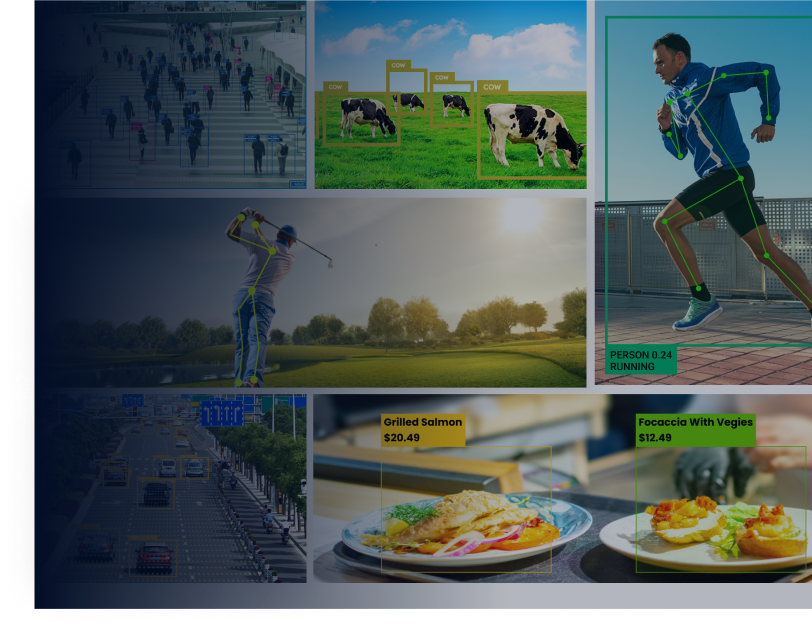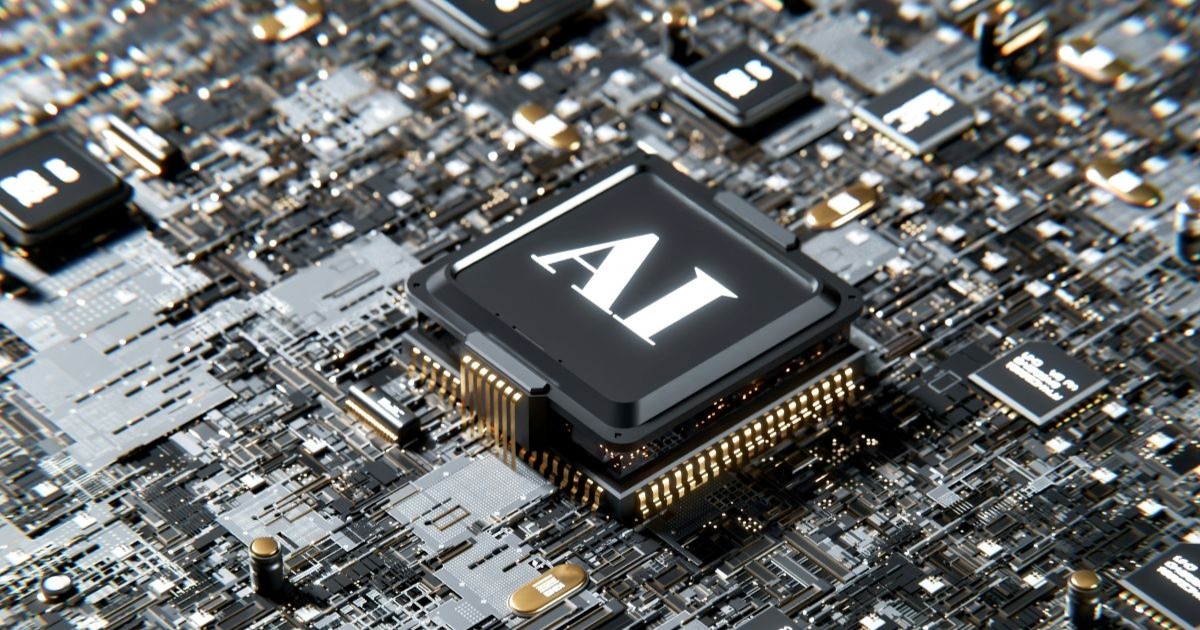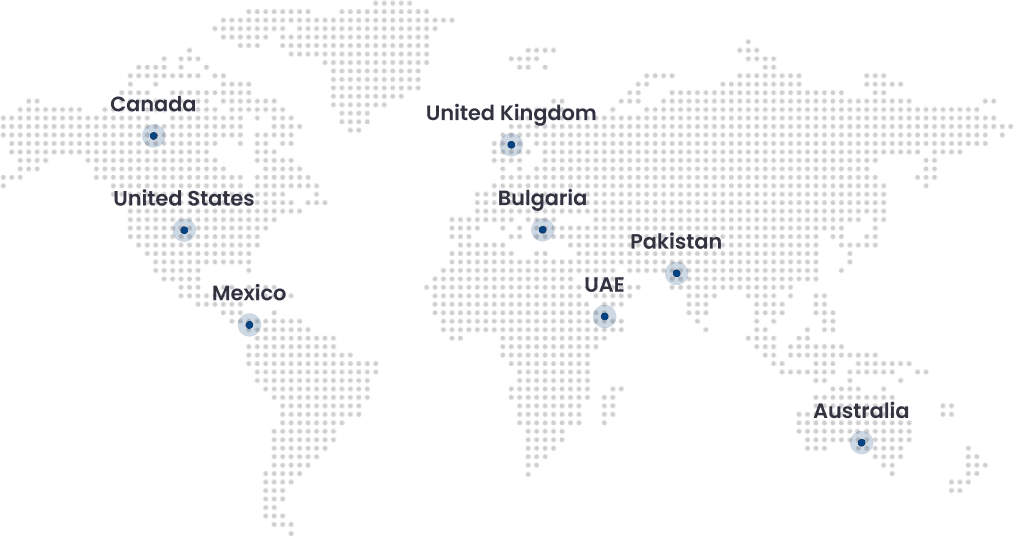Artificial intelligence continues to advance rapidly, bringing exciting new technologies that transform how we work, create, and interact with digital systems. With these developments comes natural curiosity about the difference between OpenAI and generative AI. Many people use these terms interchangeably, though one refers to a specific company while the other represents an entire category of AI technology.
This guide clarifies the OpenAI vs generative AI discussion in simple, practical terms, helping you make informed decisions for your business or personal AI projects. Understanding these distinctions empowers organizations to select the right tools and strategies for their needs and goals.
What is generative AI?
Generative artificial intelligence (AI) is a powerful category that creates new content across multiple formats, including text, images, code, music, and video. Rather than simply analyzing existing data, AI actively produces original content that demonstrates creativity and intelligence similar to human output.
This technology transforms how businesses approach content creation, enabling rapid production of marketing materials, software development, creative assets, and personalized user experiences at an exceptional scale and efficiency.
For example, ChatGPT can write articles, DALL-E creates artwork from descriptions, and GitHub Copilot generates programming code automatically.
Core applications of generative AI
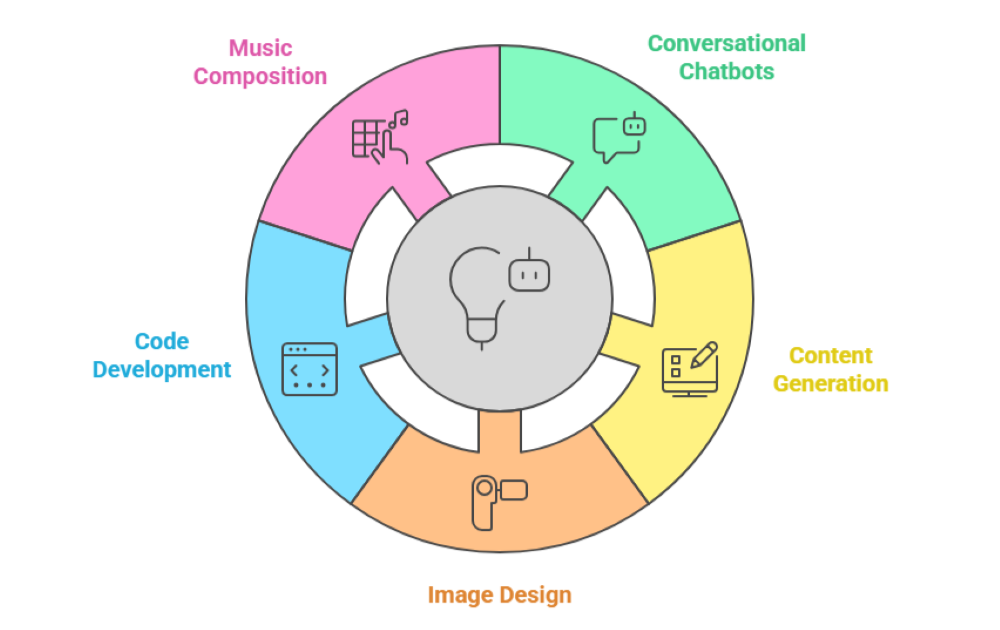
Today’s businesses leverage generative AI across numerous applications that streamline operations and enhance creativity across various departments and functions.
- Conversational chatbots provide 24/7 customer support, answer frequently asked questions, guide users through complex processes, and handle multiple customer inquiries simultaneously with human-like responses.
- Content generation automates marketing copy creation, produces blog articles at scale, generates social media posts, creates email campaigns, and develops creative writing for various business purposes.
- Image design and creation transform simple text descriptions into professional graphics, product mockups, marketing visuals, logo concepts, and custom illustrations without requiring design expertise.
- Code development assists programmers by writing functions, debugging existing code, creating entire applications, translating between programming languages, and automatically generating documentation for software projects.
- Music composition creates original video soundtracks, generates background music for presentations, composes jingles for advertisements, and produces royalty-free audio content for various media projects.
Explore more about Generative AI for Marketing
Technology foundation:
Generative AI systems are powered by deep learning and large language models (LLMs) that process extensive training data to understand patterns, context, and relationships. These advanced models include:
- Transformer architectures like GPT (Generative Pre-trained Transformer) use attention mechanisms to understand context and relationships between words, enabling coherent text generation across various topics and styles.
- Diffusion models for image generation, such as Stable Diffusion, gradually refine random noise into detailed images by learning to reverse a corruption process during the training phase.
- Variational autoencoders (VAEs) compress input data into compact representations and then reconstruct new variations, generating similar but unique content from learned patterns.
- Generative adversarial networks (GANs) employ two competing neural networks, one of which creates content while the other evaluates authenticity, resulting in increasingly realistic generated outputs.
- Multi-modal models simultaneously process and generate content across text, image, and audio formats, enabling complex tasks like describing images or creating visuals from text descriptions.
Popular generative AI models span various companies, including GPT-4, Claude, BERT, DALL·E, Midjourney, and Stable Diffusion, each offering unique capabilities and specializations.
What is OpenAI?
OpenAI is an artificial intelligence research company founded in 2015 with the mission to ensure that artificial general intelligence (AGI) benefits all of humanity. Unlike generative AI, which represents a technology category, OpenAI is a specific organization that develops, researches, and commercializes AI systems.
The company has become the creator of well-known models that many people use daily. Their popular products include GPT-3, GPT-4, DALL·E, Codex, and ChatGPT, each representing major advances in their respective areas. OpenAI offers APIs and products for developers and enterprises, making advanced AI capabilities accessible through user-friendly interfaces and developer tools.
OpenAI’s key offerings
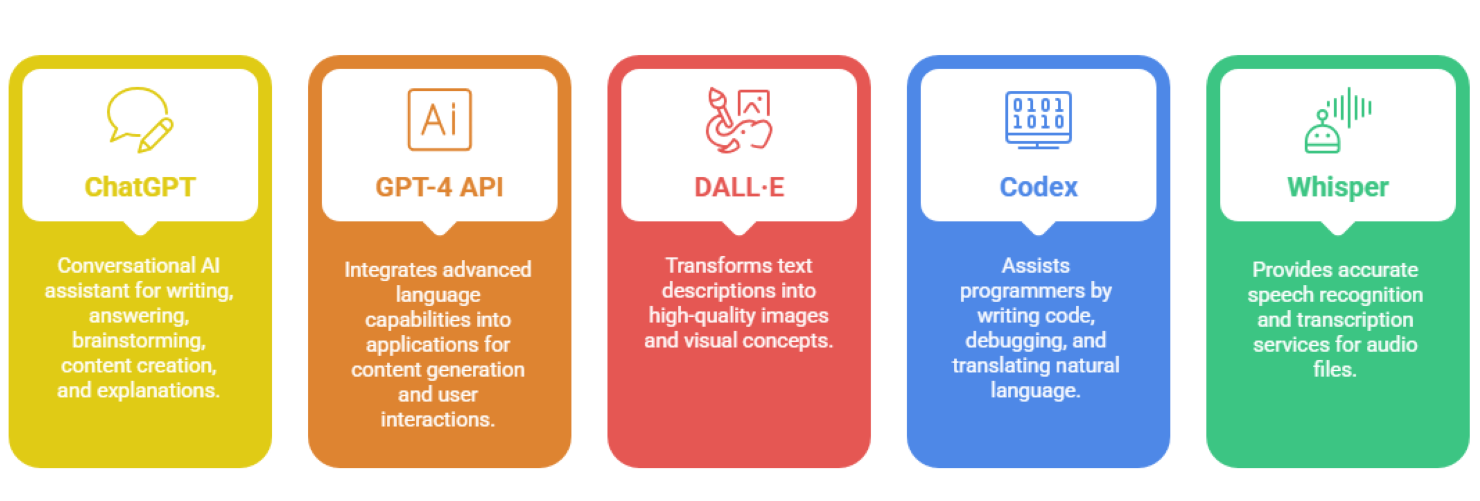
OpenAI has developed several groundbreaking products that have become essential tools for businesses, developers, and individuals seeking AI-powered solutions for various applications.
- ChatGPT is a conversational AI assistant for writing tasks, answering questions, brainstorming ideas, creating content drafts, and providing detailed explanations on complex topics.
- GPT-4 API enables developers to integrate advanced language capabilities into custom applications, websites, and software solutions for automated content generation and intelligent user interactions.
- DALL·E transforms text descriptions into high-quality images, artwork, and visual concepts, allowing users to create custom graphics without traditional design skills or software.
- Codex powers GitHub Copilot and assists programmers by writing code snippets, completing functions, debugging errors, and translating natural language instructions into executable code.
- Whisper provides accurate speech recognition and transcription services. It converts audio files into text and supports multiple languages and various audio quality levels.
OpenAI has established itself as a leading company in the generative AI ecosystem, consistently advancing what’s possible with artificial intelligence while maintaining focus on safety and beneficial deployment.
Key differences between OpenAI and generative AI
| Feature | OpenAI | Generative AI |
| Type | Company / Organization | Technology Category |
| Role | Builds AI tools & models | Encompasses all AI systems that generate, predict, and create |
| Scope | A specific company with targeted products | Broad field including multiple companies and diverse applications |
| Models/Tools | GPT-3, GPT-4, ChatGPT, DALL·E, Codex | Includes OpenAI, Anthropic Claude, Google Gemini, Meta LLaMA |
| Example Use | ChatGPT for writing emails and customer service | Midjourney for design, drug discovery models, and synthetic data generation |
| Applications | Text, images, code, and conversation | Content creation, scientific research, data analysis, and automation |
| Business Model | API subscriptions, enterprise licenses, and consumer products | Various models across different companies and platforms |
How are they connected?
The relationship between generative AI and OpenAI is collaborative, with OpenAI serving as both a pioneer and major contributor to the broader generative AI ecosystem.
- OpenAI builds generative AI models that have established industry benchmarks, influenced research directions, and provided foundational technologies that other companies build upon and improve.
- OpenAI operates as a leader in generative AI development and research, but represents one major player in a larger ecosystem that includes Google, Meta, Anthropic, and numerous other companies.
- Generative AI encompasses technologies from multiple companies, including Google’s Gemini for search and productivity, Anthropic’s Claude for reasoning, Meta’s LLaMA for open-source development, and Stability AI’s image generation tools.
- OpenAI’s research and models have accelerated field advancement by making sophisticated AI capabilities accessible through APIs, enabling developers worldwide to build innovative applications and services.
- The broader generative AI field benefits from OpenAI’s research publications, open development approaches, and API accessibility, which foster collaboration and innovation across academic and commercial sectors.
Explore this guide how to Integrate AI Into Your App
Real-world applications
Understanding practical applications helps clarify the comparison of the AI model between OpenAI-specific tools and broader generative AI solutions.
OpenAI applications
- ChatGPT for content creation generates blog posts, social media captions, email newsletters, product descriptions, and marketing copy that saves businesses hours of writing time while maintaining brand voice consistency.
- GPT-4 for document processing analyzes PDF files, extracts key information from reports, summarizes lengthy documents, and converts unstructured data into organized formats for business intelligence and decision-making.
- DALL·E for brand asset creation produces custom logos, social media graphics, website banners, presentation slides, and promotional materials that maintain visual consistency across all marketing channels and platforms.
Broader generative AI applications
- Drug discovery and molecular design using specialized AI models from companies like DeepMind and Recursion accelerate pharmaceutical research, identify potential treatments, and reduce development costs from billions to millions.
- Scientific research and simulation through platforms like Google’s AlphaFold predict protein structures, enable breakthrough discoveries in biology, and advance understanding of complex molecular interactions for medical applications.
- Financial risk assessment and fraud detection use generative models from firms like Palantir and DataRobot to analyze transaction patterns, identify suspicious activities, and prevent financial crimes in real time.
Why does the confusion exist?
The widespread mixing of generative AI and OpenAI terms stems from several factors that have shaped public perception of artificial intelligence.
OpenAI’s worldwide success
ChatGPT created widespread public awareness and media attention, making the company synonymous with AI innovation for many consumers and establishing strong brand recognition globally.
Media coverage
Media often uses “AI” and “OpenAI” interchangeably in headlines and articles, contributing to misconceptions about the broader technology field and creating unclear distinctions between the company and the technology category.
ChatGPT’s rapid adoption
ChatGPT reached 100 million users faster than most consumer applications in history, creating a strong association between OpenAI and AI capabilities in the public consciousness and mainstream awareness.
Marketing and branding
Marketing efforts by OpenAI have successfully positioned the company as a recognizable name in modern AI development, making their products the first AI tools many people encounter.
Growing awareness
The efforts of other players in the generative AI space among general consumers and business leaders are still developing, leading to an oversimplified understanding of the diverse competitive environment.
Choosing the right Generative AI platform
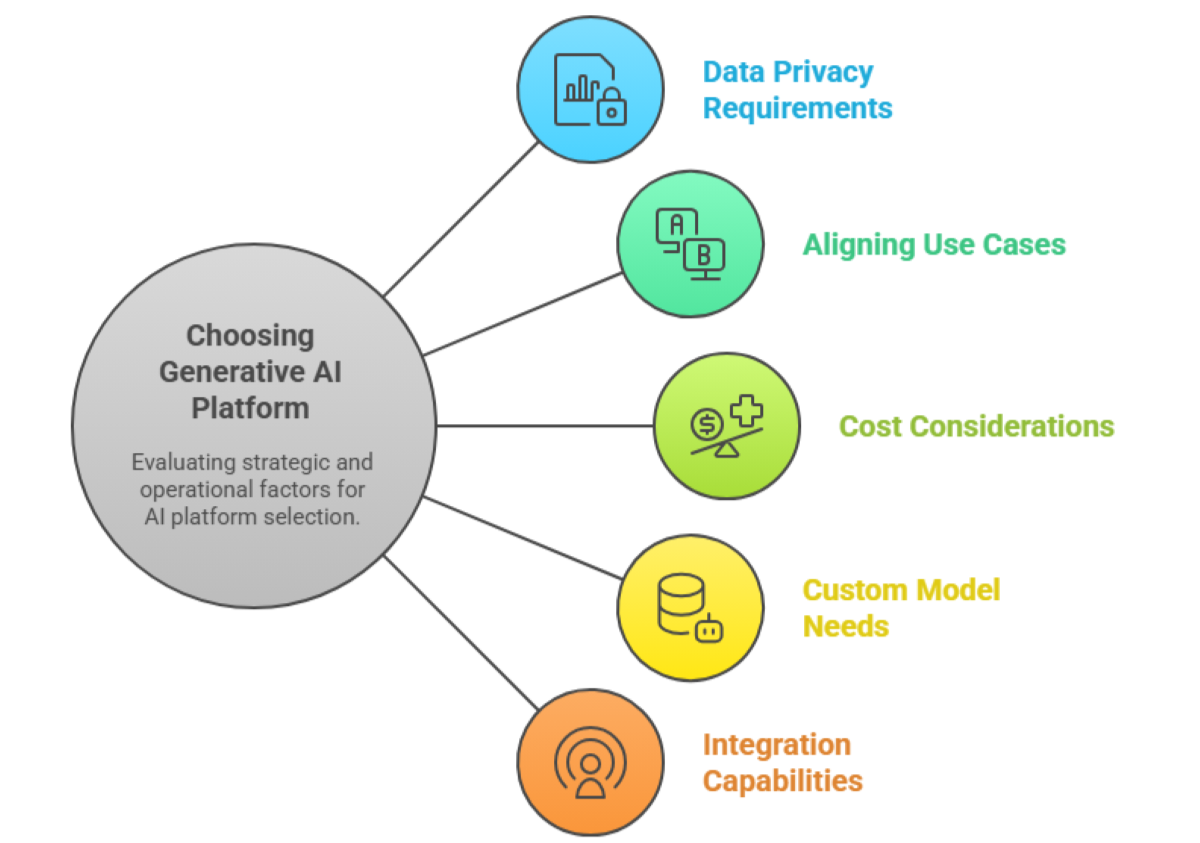
Businesses should consider multiple strategic and operational factors when evaluating whether to use OpenAI or another generative AI platform.
- Data privacy requirements and compliance with industry regulations like GDPR, HIPAA, or SOX determine which platforms can safely handle sensitive information and meet organizational security standards and legal obligations.
- Aligning specific use cases with available models and capabilities across different platforms ensures optimal performance, as some AI systems excel at text generation while others specialize in image creation or code development.
- Cost considerations, including API pricing, subscription models, and total cost of ownership, help organizations budget effectively and compare value propositions across different AI service providers and pricing structures.
- Custom model needs and the ability to fine-tune or train specialized models for unique requirements determine whether off-the-shelf solutions suffice or custom development is necessary for specific business applications.
- Integration capabilities with existing systems, workflows, and technology stacks affect implementation complexity, ongoing maintenance requirements, and the ability to seamlessly incorporate AI tools into current business processes.
AI consultants and specialists are valuable in guiding these decisions by conducting thorough assessments of business needs, technical requirements, and strategic objectives. Professional guidance ensures optimal platform selection and implementation success.
How Folio3 AI can help with generative AI solutions
Folio3 AI is a leading generative AI development company with over 15 years of experience serving 1000+ enterprise-level clients. We deliver comprehensive AI solutions that transform business operations through custom model development, strategic implementation, and ongoing optimization.
Our comprehensive generative AI services:
- Custom AI Model Development creates tailored solutions using advanced architectures like GANs, VAEs, transformers, and reinforcement learning to address your industry’s unique challenges and business requirements.
- AI Model Fine-tuning and Optimization adjusts existing models using your proprietary data, ensuring optimal performance, accuracy, and efficiency for your specific use cases and operational environments.
- LLM Model Selection and Integration helps you choose and implement the best Large Language Models (GPT-4, PaLM 2, LLaMA, Claude) that align with your business objectives and technical specifications.
- Autonomous Agent Development builds intelligent systems that make independent decisions and perform tasks using reinforcement learning, perfect for robotics, virtual assistants, and automated business processes.
- MLOps Infrastructure and Deployment creates a robust baseline infrastructure for seamless model deployment, monitoring, and maintenance while automating the entire machine learning lifecycle for operational efficiency.
Final thoughts
The distinction between OpenAI and generative AI is important yet often misunderstood: OpenAI is a company that develops and commercializes artificial intelligence systems, while generative AI is the broader technology field encompassing all AI systems capable of creating new content. OpenAI represents one significant player in the expansive generative AI ecosystem, alongside companies like Anthropic, Google, Meta, and many others contributing to this exciting technology category. Both OpenAI’s innovations and the broader generative AI field offer tremendous opportunities for digital transformation and competitive advantage.
Ready to harness the power of generative AI for your business? Talk to our AI experts today and discover how we can build custom solutions tailored to your unique requirements.
Frequently asked questions
1. What’s the main difference between OpenAI and generative AI?
OpenAI is a specific AI research company that develops tools like ChatGPT and DALL-E, while generative AI is the broader technology category that includes AI systems from multiple companies. Think of OpenAI as one major player in the generative AI field, similar to how Apple is one company in the broader smartphone industry.
2. Can I use generative AI without using OpenAI products?
Yes, absolutely! Many companies offer excellent generative AI solutions, including Google’s Gemini, Anthropic’s Claude, Meta’s LLaMA, and Stability AI’s image generation tools. Each platform has unique strengths, pricing models, and capabilities that may better suit your specific business needs and requirements.
3. Which is better for my business: OpenAI or other generative AI platforms?
The best choice depends on your specific use case, budget, data privacy requirements, and integration needs. OpenAI excels in conversational AI and content generation, while other platforms may be better for specialized tasks like scientific research, enterprise security, or custom model development.
4. Does generative AI only create content like text and images?
No, generative AI has much broader applications beyond content creation. It’s used in drug discovery, financial risk assessment, climate modeling, manufacturing optimization, scientific research, synthetic data generation, and predictive analytics. Content creation is just the most visible consumer-facing application of this powerful technology.
5. How can my company implement generative AI effectively?
Start by identifying specific business challenges that AI could solve, then evaluate different platforms based on your requirements. Consider partnering with experienced AI development companies like Folio3 AI to assess your needs, develop an implementation strategy, and ensure successful integration with your existing systems and workflows.

Laraib Malik is a passionate content writer specializing in AI, machine learning, and technology sectors. She creates authoritative, entity-based content for various websites, helping businesses develop E-E-A-T compliant materials with AEO and GEO optimization that meet industry standards and achieve maximum visibility across traditional and AI-powered search platforms.

